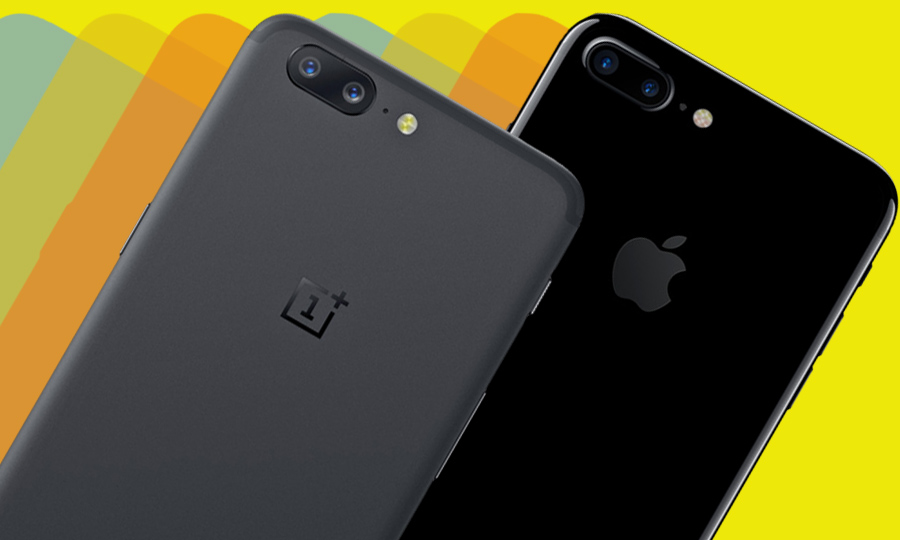OnePlus 5 vs. iPhone 7 Plus: Dual Camera Shootout
The OnePlus 5 is the latest phone to hop on the dual-camera bandwagon, but can it top the iPhone 7 Plus for quality?
Pretty soon, every phone will have dual rear cameras, whether the phone sells for $100 or $750. One of the most recent devices to jump on the dual-cam trend is the OnePlus 5, our new favorite midrange phone. But how does it stack up to the dual-camera iPhone 7 Plus?

From a pure numbers standpoint, the $479 OnePlus 5 might seem to have an advantage, as its dual-camera setup is made up of a primary 16-megapixel 24mm f/1.7 camera and a secondary 20-MP 36mm f/2.6 camera with a 2x lossless zoom. Meanwhile, the $769 iPhone 7 Plus features a pair of 13-MP rear cameras: a main camera with a 28mm f/1.8 lens, and secondary camera with a 56mm f/2.6 lens and true 2x optical zoom.
However, you probably know by now that megapixel count isn't everything. There are a number of other factors that can have a much bigger impact on picture quality than resolution, such as the iPhone 7 Plus featuring optical-image stabilization on both rear cameras; the OnePlus 5 features electronic-image stabilization on its primary camera only.
MORE: OnePlus 5 Review: A Midrange Masterpiece
So to see how well the OnePlus 5 fares against the much more expensive iPhone 7 Plus, we challenged both phones to shoot a series of photos across a wide variety of conditions using both primary and secondary cameras.
Photo Quality: Apple on top, but the OnePlus 5 is very good
Let’s start by comparing each phone's primary camera. In bright light, the OnePlus 5's 16-MP main camera keeps up pretty well with the iPhone 7 Plus' 13-MP primary shooter. However, there are a couple of areas where iPhone still shows its dominance.
In a shot of some handcrafted paper decorations, the iPhone's picture sports more accurate colors, with saturated blacks and rich but still neutral reds. Meanwhile the OnePlus 5's shot looks yellowed and faded, though if you take a closer look, the OnePlus 5's shot does appear to be a tiny bit sharper than than the iPhone's.
When I snapped some flowers, the iPhone once again held a slight advantage in a picture with better dynamic range and detail. In the OnePlus 5's pic, the edges of the flower petal are on the verge of being blown out and the camera's image-processing gives the petal a fried, leathery appearance — something you don't see in the iPhone's pic.
At sunset, I challenged both phones with the difficult task of catching the day's fading light, and while each captured something that most people would be quite happy with, the iPhone's pic reigned supreme. The iPhone just captures so much more depth and color in the clouds and sky, especially the faint wisp of pink in the center. Some folks might prefer the richer blue tones in the OnePlus 5's, but that's not enough to give it the win.
In a dark room with the lights of and the shades drawn, it's more of a toss-up, as each phone produced very different looking photos. The iPhone 7 Plus' pic is overly yellow, but it's better exposed and less grainy than the OnePlus 5's shot. However, the OnePlus 5 nailed the colors, and was much more accurate as to what the room actually looked like.
Secondary Cameras: Not all zooms are created equal
Before we look at each camera's zoom shots, we need to understand how they work first. The iPhone 7 Plus uses a 56mm equivalent lens to provide a true 2x optical zoom, while the OnePlus 5 uses a 36mm lens to create 1.66x optical zoom and then uses some clever computational photography to reach what the company calls a 2x lossless zoom. Theoretically, the OnePlus 5's zoom photos should offer the same level of quality as using a lens with a longer focal length.
But there's one other thing to consider. In the case of both the OnePlus 5 and iPhone 7 Plus, if the phone thinks there isn't enough light to produce a good picture, it defaults back to the primary camera — which has a wider aperture that lets in more light than the secondary camera — and will use a 2x digital zoom instead. In those situations, you could physically cover up the second lens, and it wouldn't make a difference. That effectively means you can't use either phones' 2x zoom in low light, and there's no way to force it even if you want to, which is kind of a shame.
In general, I found that the iPhone's zoom camera is slightly more tolerant of low light than the OnePlus 5's, but not by much. In another sunset shot, I was able to use the 2x zoom on both cameras despite the fading light. The EXIF data confirms, as the iPhone 7 Plus' shot says it was taken using an f/2.8 lens, while the OnePlus 5's shot was taken using a f/2.6 lens.
However, despite the OnePlus 5's wider aperture, the iPhone's pic is slightly brighter and better exposed. This can be seen most notably if you zoom in and look for the word "Lackawanna" on the side of the bridge with the lighted arches. It's dark, but visible in the iPhone's and nearly unidentifiable in the OnePlus 5's pic. Additionally, the iPhone's pic is a tiny bit less noisy and has more richness in the pink and orange sky in the background. It's close, but the iPhone's pic is the best.
MORE: OnePlus 5 vs. iPhone 7: Why Apple Loses
Another function of the the phones' zoom cameras is portrait modes, which let you take photos with very shallow depth of field to simulate what you might get on an expensive DSLR or mirrorless camera with a very wide aperture lens. Unlike the standard zoom comparison, this head-to-head comparison wasn't even close.
The OnePlus 5's portrait shot blurs the entire image, so that a photo of our intern features softness across her whole face. In fact, it appears that the OnePlus uses the secondary camera only for depth information, as the actual image was taken using the OP5's primary 16-MP shooter.
This gives the iPhone 7 Plus' portrait mode another edge, since its 56mm secondary lens is much closer to the focal length that many professional shooters use when capturing portraits. And finally, because the iPhone 7 Plus' selective focus is much less aggressive, you get better focus on your subject's face and less distracting blurring around the outside.
Bottom Line
The work OnePlus has done on the 5's main camera is pretty impressive. It's sharp, quick to shoot and captures wonderfully colorful images that can hang with those from the iPhone 7 Plus. However, when it comes to getting the most out of both its rear cameras, OnePlus still has a thing or two to learn from Apple.
Credit: Sam Rutherford/Tom's Guide
Sign up to get the BEST of Tom's Guide direct to your inbox.
Get instant access to breaking news, the hottest reviews, great deals and helpful tips.
Sam is a Senior Writer at Engadget and previously worked at Gizmodo as a Senior Reporter. Before that, he worked at Tom's Guide and Laptop Mag as a Staff Writer and Senior Product Review Analyst, overseeing benchmarks and testing for countless product reviews. He was also an archery instructor and a penguin trainer too (really).
